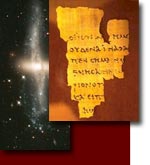| Site Map | Contacts | Links | Newsletter | |
Genesis 1:24-31 DAY 6
Man
Hebrew Text
wnmlxb <da h?un - Let us make man in our image
Let us make
The Hebrew h?un, "let us make" is plural. The early Christian church took this phrase as referring to the trinity. Early Jewish commentators took this phrase as referring to the heavenly court of angels. It used to be taken as a "plural of majesty" but "we" is not used with verbs this way (Wenham 1987, 28). Today some called it a "plural of self-deliberation (Ibid.). The best interpretation seems to be that God is giving a divine announcement to the heavenly court of angels (See Job 38:7; Wenham, 28).
Jewish Literature
Man-Adam
There are three different ways <da "adam" is used in Genesis. "Adam" can just mean the generic term for mankind in general, or male in particular. In Genesis 1:27 the term "adam" includes both male and female referring to all humanity. In Genesis Two "adam" refers to a male in contrast to a female. The second use is a historical person named Adam. Hess states that not until chapter 4:25 is a historical person meant (Hess 1997, 31). The third use of "adam" as a title, is seen in ancient Near Eastern parallels where the lu-sign for ruler means "man" (Hess 1990, 7).
The name "adam" in Genesis seems to be a word play with the name for "ground, adamah" from which man was formed (Hess 1997, 31). The root word for "adam" means "red" (Hess 1993, 15).
The historical Adam may be the same man named "Allum" the first king in the Sumerian King List who lived before the great flood. He was the first king of Eridu which may be the Biblical Eden. Adam is also equated with Adapa, the first sage (Shea 1977, 27; Fischer 1996, 308).
Akkadian Literature
An old Babylonian text tells of the creation of man by the mother goddess. It says,
Thou art the mother-womb,
The one who creates mankind.
Create, then, Lullu (savage, first man) and let him bear the yoke!
The yoke he shall bear,
The work of god man shall bear!
Let one god be slain,
And let the gods be purified by immersion
In his flesh and his blood.
Let Nintu mix clay,
God and Man,
Let them together be smeared with clay (ANET, 99-100).
Several other stories tell about man being made from clay. Sometimes the clay is mixed with the blood of a god.
The earliest known story dealing with manís creation is Enki and Ninhah which says:
And when Enki, the-fashioner-of-the-forms,
pondered by himself their nature,
He said to his mother, Nammu:
My mother, the creature which you named,
will verily exist; impose (on him)
the burden of the gods!
When you have mixed the heart of
the clay on top of the Abzu,
The two birth-goddesses shall nip off
pieces of clay. When you yourself
have given (it) form.
[Thus] she created mankind
ma[le and female...] (COS, 517).
Image
The other key word is the meaning of "image." Is this to be taken physically or spiritually? The preposition b in this phrase means "According to, after the pattern of" (Wenham 1987, 29). A close parallel is in Exodus 25:40 where Moses is told to build the tabernacle "after the pattern" seen on the mountain.
There are five main views of the meaning of "image." (1) The likeness is two aspects of manís nature. This is according to early Christian views like Irenaeus. (2) The image refers to the mental or spiritual side of man. (3) It is the ability to relate to God, to have a relationship with God. (4) The image makes man Godís representative on earth. Man is Godís vice-regent on earth. (5) The image is physical. In the ANE kings were considered to be the "image of God" even the very "son of god." This does not mean the king looked like God but describes the kings divine right and function as ruler. It seems that view 4 can be combined with view 5. The king is ruling in Godís place. Man is to rule over all of creation on earth (verse 26). This same word "image" is used in Genesis 5:3 when Seth is "after his (Adamís) image." Although man had much in common with animals, it was being in the "image of God" that made him different (Wenham, 30). It seems the Hebrews have democratized the "image of God" to refer to all mankind, and not just the king.
Egyptian Literature
On a stele of Amenophis II from Amada the pharaoh is called "the beloved son in bodily form of Re—image of Horus on the throne of his father" (Westermann, 152). Pharaoh is also called "the glittering image of the Lord of all" and the Pharaoh says, "I am his son (that is of Osiris)" (Ibid., 153). In another text Amon-Re addresses Amenophis III saying, "Thou art my beloved son, come forth from my limbs, my very own image, which I have put upon the earth. I have permitted thee to rule over the earth in peace" (Ibid.). From these texts we see that the Pharaoh was the "image of god," godís representative on earth. This is similar to Psalm 8.
Hebrew Text
wbrw wrp - Be fruitful and multiply
Man is commanded to be fruitful and multiply. Here is a statement on the divine purpose of marriage which is for the procreation of children. This is also a rejection of the ancient fertility cults which marks unbelief (Genesis 16; 30:14-15).
